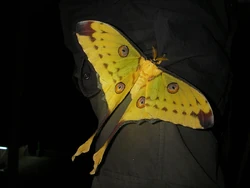| Comet Moth | |
|---|---|
 | |
| Information | |
| Common Name | Madagascan Moon Moth |
| Range | Madagascar |
| Scientific Classification | |
| Kingdom | Animalia |
| Phylum | Arthropoda |
| Class | Insecta |
| Order | Lepidoptera |
| Family | Saturniidae |
| Genus | Argema |
| Species | Argema mittrei |
The comet moth, also known as the Madagascan moon moth, or by its scientific name Argema mittrei, is a species from the argema genus. It is native to the rain forests of Madagascar, and was first discovered by Félix Édouard Guérin-Méneville in 1847.
Etymology[]
The genus name "Argema" is the Greek word for 'speckled eye', alluding to the moth's large eyespots on each wing. Their common name refers to their long tails that appear like the tail of a comet.
Appearance[]
Eggs are small, dirty white, and round. Caterpillars turn bright green before they start to putate. Pupae are silvery-grey and possess drainage holes so rainwater does not drown the develping butterfly inside. Butterflies have greenish-yellow wings with one large eyespot on each of their four wings. Males have longer tails and antenna that is feathery and long, while females have rounder wings and are larger overall. The dimensions of a male Comet Moth are approximately 20 cm (7.9 inches) across their wings and 15 cm (5.9 inches) along their tails.
Life Cycle[]
The adult moth lays from 100 to 150 eggs that take 10-20 days to hatch. The caterpillars then feed voraciously on host plants such as cider gum, sweetgum, and marula, for two months before pupating and emerging as butterflies from May-June. This entire process will last about 70–85 days. Adults have defunct mouths, meaning they are unable to feed, and are only able to live for 5 days. During this time, males are responsible for finding a mate.
Adaptations[]
Male moths have feathery antennae to detect the pheromones of female moths. They also possess spinning tails to confuse the ecolocation of bats and trick them into attacking their tails rather than more vulnerable parts of their bodies. Eyespots are present on the wings to fool predators into thinking the moth is a dangerous creature that shouldn't be attacked.
Conservation[]
Comet Moths are threatened by deforestation, which has destroyed 90% of Madagascar's native forests.
Trivia[]
- The Comet Moth previously appeared in the 1000 Malagasy ariary banknote.
References[]
- "Comet moth." Wikipedia, en.wikipedia.org. Accessed 22 June 2022.
- "Comet Moth (Argema mittrei)." Moth Identification, www.mothidentification.com/. Accessed 22 June 2022.
- "Madagascar Comet Moth - Argema mittrei." The Butterfly Babe, www.thebutterflybabe.com/. Accessed 22 June 2022.
- Osterloff, Emily. "Spotlight: the Madagascan moon moth." Natural History Museum, www.nhm.ac.uk/. Accessed 22 June 2022.
